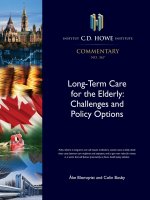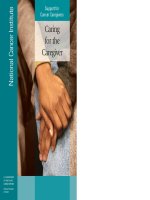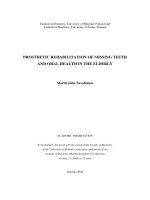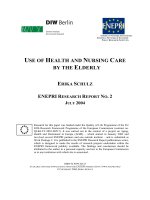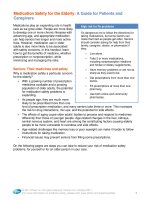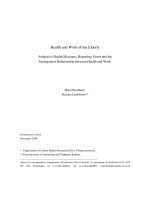iCare: A Mobile Health Monitoring System for the Elderly pptx
Bạn đang xem bản rút gọn của tài liệu. Xem và tải ngay bản đầy đủ của tài liệu tại đây (370.42 KB, 7 trang )
iCare: A Mobile Health Monitoring System for the Elderly
Ziyu Lv, Feng Xia, Guowei Wu, Lin Yao, Zhikui Chen
School of Software
Dalian University of Technology
Dalian 116620, China
e-mail:
Abstract—This paper describes a mobile health monitoring
system called iCare for the elderly. We use wireless body
sensors and smart phones to monitor the wellbeing of the
elderly. It can offer remote monitoring for the elderly anytime
anywhere and provide tailored services for each person based
on their personal health condition. When detecting an
emergency, the smart phone will automatically alert pre-
assigned people who could be the old people's family and
friends, and call the ambulance of the emergency centre. It also
acts as the personal health information system and the medical
guidance which offers one communication platform and the
medical knowledge database so that the family and friends of
the served people can cooperate with doctors to take care of
him/her. The system also features some unique functions that
cater to the living demands of the elderly, including regular
reminder, quick alarm, medical guidance, etc. iCare is not only
a real-time health monitoring system for the elderly, but also a
living assistant which can make their lives more convenient
and comfortable.
Keywords-healthcare; assisted living; health monitoring;
body sensor; medical guidance
I. INTRODUCTION
The aging people in the contemporary society have
brought great pressure and many seniors have been living
alone without anyone accompanied because their offspring
are busy with work and have to struggle with severe
competition. For those seniors who live independently in
their own homes, there is an increasing risk of falls and
strokes which could threaten their lives. A lot of money and
research effort has been spent on making people aware of the
warning signs [1]. Getting the elderly to recognize the
warning signs is not easy. And it indicates that people who
have had a heart attack have a sudden death rate that is 4 to 6
times that of the general population [2]. The New England
Journal of Medicine draws a conclusion that the chances of
surviving a fall, heart attack or stroke are six times greater if
the elderly get help within an hour. Therefore, the elderly
with no one accompanied need real-time monitoring to
reduce the anxiety of them and the risk of accidents.
However, the financial and staffing cost of caring for the
increasing numbers of aged persons in nursing homes or
hospitals will be a huge challenge. In this background, a very
worthy and challenging issue is how to provide the elderly
with the real-time, long-term and nonintrusive assisted living
and remote healthcare services.
With the development of the technologies such as mobile
computing, distributed computing and wireless sensor
network, it is possible to provide the elderly with healthcare
services that can monitor the elderly anytime anywhere.
Various wireless communication motes cooperate with
medical sensors to support healthcare and monitor people's
health, especially the elderly suffering from diabetes, high
blood pressure or heart disease [3]. For instance, in Australia,
Pro Medicus makes a success of IT Healthcare [4]. It
develops one secure intelligent system for transmitting
medical results to doctors. Wireless sensor network provides
the useful method to remotely acquire and monitor
physiological signals without the need of disrupting the
patient's normal life [5-9].
We intend to develop a mobile health monitoring system,
called iCare. It can monitor the old people anytime and
anywhere. Through vital physiological data monitoring,
accidents perception, real-time emergency response and
other functions, our system will reduce sudden accidents and
life-threatening [10, 11]. It is convenient that the elderly can
have access to medical care at home. At the same time, we
feature auxiliary functions which cater for the need of the
elderly without anyone accompanied or health professionals
as their life assistant. Therefore, the system iCare acts as not
only one remote health monitoring system, but also the life
assistant. Moreover, it will help establish the health
insurance system and contribute to the aging society.
The rest of the paper is set out as follows. Section 2
outlines related work. The requirements and system design
of the system iCare are described in Section 3 and Section 4
respectively. Section 5 illustrates the prototype of iCare and
shows user interface. Section 6 concludes this paper.
II. R
ELATED WORK
Today, personal healthcare is one of emerged areas of
research. Rodriguez et al [12] have made a classification
which divides the solutions into three groups. The first group
records signals and takes action off-line. The second group
has the feature that systems perform remote real-time
processing. The last group provides local real-time
processing, with taking into account the level of mobility.
The Holter device that records patients’ ECG for 24 to 48
hours is analyzed afterwards by doctors. Therefore, Holter
belongs to the group one. The drawback of Holter devices
are their deficiency in offering real-time monitoring and no
immediate action when the accident occurs. In order to
overcome the restriction, many systems and devices are
developed. Vitaphone commercializes a card that can
transmit ECG data to a mobile phone. The mobile phone
automatically transmits ECG data to the service center where
ECG data are analyzed [13]. Similarly, Cardio Control [14],
MediSense [15] and MobHealth project are all included in
the group two, using mobile phone/PDA to get physiological
signals and sending signals to other devices in which
physiological signals are remote real-time monitored.
Besides, MORF is also one respective application of the
second group. It uses mobile phone as an intermediary to get
vital data from various sensors and transmit data to the server
which processes the data [16]. However, the above
applications still present certain limitations related to the fact
that the analysis is not performed in the place where the
signal is acquired. There may be a loss of efficiency in the
wireless network when physiological signals are sent.
Compared with the group two, the third group performs
the local real-time monitoring in order to detect some
anomalies and send alert to a control center or a hospital. Wu
et al [17] proposes a wearable personal healthcare and
emergency aid system called WAITER. It employs tiny
wearable sensors to continuously collect users’ vital signals
and uses Bluetooth devices to transmit the sensory data to a
mobile phone, which can perform on-site vital data storage
and processing. After local data processing, the mobile
phone can periodically report users’ health status to the
healthcare centre via its GSM module and issue alert for
medical aids when detecting the emergency. But it only
develops one relatively static monitoring system in which the
status is set statically and doctors are called when mobile
phone send alert messages. It is not sufficient in real-time
and dynamic monitoring. Prognosis [18] is a physiological
data fusion model of wearable health-monitoring system for
people at risk which contains decision support system and
finite-state machine. It can estimate users' health status and
offer corresponding alerts. Gay and Leijdekkers [19] have
developed one application that can monitor the wellbeing of
high risk cardiac patients using wireless sensors and smart
phones. Depending on the situation, the smart phone can
automatically alert pre-assigned caregivers or call the
ambulance. Although it performs real-time monitoring, it
still does not consider the increasing life demand of the
elderly. And it only provides real-time monitoring rather
than real-time healthcare services.
Our system is also a mobile health system for the elderly
with tailored services depending on their personal health
condition. However, it is not only a remote and real-time
monitoring system which takes both doctors and the old
people's family and friends into account, but also a life
assistant of the elderly including unique auxiliary functions.
The unique auxiliary functions cater to the increasing life
demand of the elderly who are with nobody accompanied. It
also integrates both the health information system and
medical guidance to assist the life of the elderly better.
Therefore, it provides convenient and indispensable
healthcare service for the elderly.
III. R
EQUIREMENTS SPECIFICATION
Our system is mainly based on the current real-time
health monitoring of old people, catering for the demand of
assisted living and the development of healthcare. We will
design one mobile health monitoring system called iCare in
order to monitor personal health of the elderly anytime and
anywhere. At the same time, the elderly not only require
real-time health monitoring, but also call for a life assistant
due to their physical status of discomfort and decline in life
skills (e.g. visual and mobility decline, memory loss).
Therefore, iCare also offers unique auxiliary functions which
are advanced when the daily demand taken into account for
the elderly as the life assistant. Moreover, we also provide
the personal health information system and the medical
guidance which contains the communication platform and
medical knowledge database. Therefore, the main functions
of our system are described below.
• A real-time mobile health monitoring system for the
elderly to monitor the health condition anytime and
anywhere.
• The personal health information system.
• The medical guidance.
• A living assistant that offers some auxiliary
functions to cater for the living demands of the
elderly.
A. Mobile Health Monitoring System
iCare is mainly a real-time mobile health monitoring
system for the elderly. With the development of mobile
computing and wireless sensor technology, combining smart
phone, body sensors and web technology can offer real-time
mobile health monitoring for the elderly. Our system will use
body sensors and devices to collect physiological signals
from the elderly and transmit them to smart phone that will
process physiological data locally and alarm automatically to
the emergency centre and pre-assigned people when data
exceed the threshold of the fixed device. The emergency
centre will call an ambulance to the current location of the
elderly. The location information can be gained from the
alarm message sent to the emergency centre. Sensors and
devices can be tailored depending on the old people's health
condition. The physiological data will be not only analyzed
locally, but also sent to the server in bulk to construct the
personal health information system. With viewing the
current and history condition of the old people in the
personal health information system, doctors remotely set the
thresholds and give advices which can guide the old people
to adjust themselves to health mode.
B. Personal Health Information System
Our system can act as the personal health information
system on the server. The smart phone gets physiological
data from sensors, and locally stores physiological data and
other information such as alarm message, advice message.
Smart phone will send those physiological data and other
information in bulk periodically to the server and the server
stores them in database to construct the personal health
information system. Doctors, family and friends of the old
people who should be granted first can access to viewing the
current and history condition of their subjects. Therefore,
doctors can know the condition of the elderly and alter
related thresholds so that dynamic monitoring can be
guaranteed.
C. Medical Guidance
The system can offer the medical guidance. It can
provide both one communication platform and the medical
knowledge database for doctors and other users including the
elderly, their family and friends. Through the medical
guidance, they can obtain medical knowledge and know
related measures immediately. That family and friends of the
elderly cooperate with doctors to monitor and assist the
elderly through the medical guidance can become the
essential part of our system. It not only makes users gain
more knowledge in the aspect of healthcare, but also
provides self-care guide service.
D. Living Assistant
In order to cater to the life demand of the old people, the
system iCare will offer unique auxiliary functions as the life
assistant, which include regular reminder, quick alarm,
location tracking, etc. Considering that the memory power of
the old people is poor, regular reminder can reminder the
elderly to take medicine at certain time and give some
advices according to the current climate situation. In order to
make the elderly alarm quickly when they feel
uncomfortable themselves, quick alarm can offer the quick-
button for immediate alarm. Location tracking is used to get
real-time location of the elderly so that they can be found
immediately when detecting emergency. The functions
above can play a vital role in the life of the elderly.
IV. S
YSTEM DESIGN
This section describes the design of the system iCare
based on the requirements. Fig. 1 shows the architecture of
our system iCare.
Figure 1. System architecture.
The system can be divided into four parts. The first one is
devices, including different body-sensors and other medical
devices. Then, the second part is smart phone that plays a
vital role in our system as an intermediary. It receives
physiological data from sensors, processes them and
transmits them to the server. Smart phone will monitor
physiological data get from sensors and automatically alert to
the emergency centre, family and friends of the elderly when
detecting the emergency. In addition, it also designs unique
auxiliary functions as a life assistant. The server is the third
one that acts as the personal health information system. In
the meanwhile, it also plays the role of the medical guidance
which can offer the real-time medical guidance for users.
The last part contains the emergency centre that will receive
alarm messages via GSM protocol and call an ambulance to
the location of the subject in the emergency status.
A. Sensors and Devices
Sensors and medical devices are necessary to collect
physiological data from the elderly in our system iCare.
Recently, cardiac disease is very common in the elderly who
are at high risk. For this reason, ECG signal is the obvious
data that needs to be collected continuously and should be
given priority over all other sensor data. At the same time,
high blood pressure is another important risk factor for
diseases [2] and regular monitoring is essential. According to
National Heart Foundation of Australia, the physical exercise
improves the live expectancy. Thus, evaluating the level of
activity of the elderly can be an important indication, which
can use an accelerometer to achieve. Moreover, being
overweight or obese should also be concerned because it
may lead to high risk disease. Therefore, in our system we
could use e.g. an integrated Bluetooth ECG/Accelerometer
sensor from Alive Technologies [20] and a Bluetooth
enabled blood pressure [21]. In addition, our system provides
tailored services which allow users to choose sensors and
devices depending on the personal health condition. The
configuration of sensors can also be set by their doctors.
B. Smart Phone
Smart phone should communicate with sensors and the
server, and send alarm messages to the emergency centre and
family of the subject when the elderly detected in the state of
emergency. It also contains some auxiliary functions such as
regular reminder, quick alarm and medical knowledge
inquiry as a life assistant of the elderly. Therefore, the
application of smart phone is complicated and plays a vital
role in our system. It is divided into nine modules. The nine
modules include data receiving, data processing, data
sending, basic information setting, configuration, inquiry,
quick alarm, location tracking and reminder. Data receiving
is used to receive data from sensors and the server, and Data
sending is the interface to send messages to the server, the
emergency centre and preset persons. Basic information
setting and configuration are used to set basic information of
all users and configuration of functions on smart phone.
Inquiry module allows the elderly to check alert records and
advices sent by doctors. Quick alarm provides the elderly
with quick button to alert to the emergency centre. The
location of the subject can be got and recorded through
location tracking module that is also essential in the alarm
function. Reminder will be used to reminder the elderly of
trivial affairs and medical events. The main module will be
described below.
1) Data receiving and data sending: Data receiving
module is designed for receiving data from sensors and the
server. Bluetooth is used when smart phone communicates
with sensors. Sensors collect physiological data from the old
people. Then, smart phone can get physiological data from
sensors via Bluetooth. Smart phone receives advice and
threshold information from doctors in the form of SMS via
GSM. Especially, data receiving module contains data-
formatted function that formats data and classifies them into
three different categories (threshold, advice and
physiological data), which must be done before data
processing module. In addition, data sending module also
uses Bluetooth for communicating with sensors. It uses
socket interface to transmit data to the server in bulk via
GPRS. Moreover, smart phone will send SMS messages to
the emergency centre, family and friends of the elderly
when generating alarm information.
2) Data processing: Data processing module is to
process data depending on different categories of data which
are get from data receiving module and take related action.
For physiological data, the monitor function will be called.
The monitor function which belongs to the data processing
module is the main function that can provide real-time
monitoring for the elderly in our system. Firstly, it stores the
receiving data in the record store, updates the old data and
notifies the elderly. Then, the value of data should be
monitored and compared with the fixed threshold that is
preset by doctor remotely. If it exceeds the threshold, the
alarm flag will be marked. When the flag is marked twice in
the adjacent monitoring, our system will call the alarm
mechanism. The alarm function will ask the subject whether
to cancel the alarm because ambient interference may
generate false alarm. If the subject cancels the alarm within
the alarm waiting time that is preset in configuration module,
iCare will return to normal mode and continue to monitor
data. Otherwise, when there is no action taken within the
alarm waiting time or the elderly confirm the alarm, our
system will automatically send alarm messages to the
emergency centre and the targets preset in family and
friends of the subject. In the monitor function, location
tracking is called for getting the location of the subject
which will be included in the alarm information.
Additionally, the system receives threshold and advice from
doctors remotely so that real-time dynamic monitoing is
guaranteed. When receiving threshold information, it will
store the information, update the threshold of the related
record and notify the elderly the arrival of the new threshold.
Similarly, if the received data is advice, the system stores
the advice, notifies the elderly of the arrival of new advice
and inquires about whether the elderly wants to cheek the
new advice.
3) Configuration and basic information setting: The two
modules are basic modules in our system. The basic
information setting module is just to record basic
information of users that include the elderly, doctors, family
and friends of the elderly. The module configuration is used
for initial and basic configuration of the system, including
system mode, device selecting, transmitted time setting and
alarm target setting. Transmitted time setting have two units:
alarm waiting time that is checked when it is time to inquiry
whether current situation is real alarm in the alarm function
of the monitor module. And transmitted time is the interval
when physiological data should be transmitted in bulk to the
server.
4) Auxiliary function: Considering the demand of the
life assistant of the elderly, some auxiliary functions are
designed on smart phone. They are inquiry, location
tracking, quick alarm and regular reminder. Inquiry can
enable users to check their alarm records and advice of
doctors. Especially, medical knowledge inquiry is designed,
which can enable users to learn any medical knowledge they
want to know or knowledge related to their diseases. The
special function is unique compared with other similar
health monitoring system. Location tracking is designed on
the phone side. It is called to get current location of the
subject which will be added in alarm messages when
alarming to the emergency centre and the subject's family
and friends preset. Combining the technology of location
tracking and GPS develops this module, which can provide
a rough indication of the location of the subject both indoors
and outdoors. Quick alarm and regular reminder are also the
unique features that cater to the demand of the elderly.
Quick alarm provides quick button that can cause alert to
the emergency centre immediately when the elderly feel
comfortless, which is very convenient for the elderly
without anyone accompanied. Considering that the memory
power of the elderly is dropping, regular reminder is
designed. Currently, we design two reminders (medicine
reminder and climate reminder) in our system. Medicine
reminder is designed to reminder the elderly to take
medicine on schedule. Users can set the frequency to
reminder themselves depending on different medicine. We
can design three modes for medicine reminder: every six
hours, every eight hours and every twelve hours. Another
reminder (climate reminder) is designed to tell the condition
of climate and advise them to take action. It uses climate
proxy server to get real-time weather information and
design climate-advice knowledge database to offer
corresponding advices. There are also three modes for
climate reminder, including every one day, every two days
and every three days. When the reminder is enabled, it will
give current weather conditions and a kindly reminder.
C. Server
The server not only acts as the personal health
information system in which physiological data and other
information can be stored and users can check all kinds of
records, but also serves as the medical guidance. The server
in our system iCare can be seen as the remote side where
doctors can use the web application and database on the
server to monitor the elderly and give related advice
remotely. Therefore, the server application can be divided
into two modules including the personal health information
system and the medical guidance.
1) Personal health information system: The personal
health system can store physiological data and other
information in the database on the server and show current
and history condition with the way of comparative. As the
server should communicate with smart phone, it has similar
module: sending and receiving module. Sending module
designs the function that can send thresholds and advice of
doctors to smart phone in the form of SMS via GSM. And
the server use socket interface to receive physiological data
and other information from smart phone in bulk. The roles
of users contain doctors, the elderly as well as family and
friends of the elderly who should be granted before. The
elderly can check their own condition via the Internet. They
can grant their family and friends in order to give different
limits of authority. The group of family and friends should
be granted by their subjects. They can have the same
function as the elderly when they are granted. Doctors are
the most important users on the server. Except that they can
check physiological data in order to know the condition of
the elderly, doctors can also update related threshold and
give real-time advice by sending SMS messages to smart
phone.
2) Medical guidance: The function is mainly catering to
the increasing demand of assisted living. It includes the
communication platform and the medical knowledge
database. The communication platform can allow doctors
and other users to communicate with each other. The elderly,
their family and friends can leave messages which can
contain medical questions and related advice for doctors.
Then, doctors can check the messages and give related
replies. Moreover, doctors can give some advices for family
and friends of the elderly when they view the current
condition of the elderly, which makes it possible that family
and friends of the elderly can cooperate with doctors to take
care of the elderly. We also design to establish the medical
knowledge database. It can guide common medical
knowledge for users, and show related advices and measures
for people who are in the emergency state but without
anyone accompanied or health professionals nearby.
Medical specialists play a vital role in building the medical
knowledge system. We offer medical specialists the right to
add medical knowledge of their area. And the other group
consisting of excellent medical specialists has access to
evaluating the existing medical knowledge, which can form
the confidence level of the evaluative criteria. Currently, we
design three confidence levels: credit, general, weak. When
the elderly, their family and friends face the emergency or
medical problem, they can inquire about medical knowledge
and related measures to solve the case immediately.
According to the keyword and area, the knowledge database
will return related medical records with their confidence
level. The medical records can be sorted by the confidence
level. In fact, the medical records of weak level will not be
recommmanded. Users have the right to set minimum level
to filter results. Moreover, the evaluative criteria should be
dynamically altered depending on medical specialists’
verification and the response of users.
D. Emergency Centre
The emergency centre can offer the emergency treatment
immediately when it receives the alarm message. The alarm
message that contains the location information is in the form
of SMS. Therefore, the emergency should develop one
application which can receive SMS message and process
messages to get the current location of the subject. Then it
calls an ambulance to the current location of the subject.
V. P
ROTOTYPE IMPLEMENTATION
Our system iCare acts as one mobile health monitoring
system for the elderly, with taking into account unique
auxiliary functions as the life assistant. Although it has been
divided into four parts in design section and every part has
different framework and platform, they are integrated by the
bend of heterogeneous network. The application executed on
smart phone is developed in Java ME with MVC structure. It
implements the real-time health monitoring and some unique
auxiliary functions such as regular reminder, quick alarm and
location tracking. The web application on the server is
developed in JSP. It not only acts as the personal health
information system, but also serves as the medical guidance.
In the first stage of prototype, we mainly focus on the main
user interface and unique cases of our project.
A. Main Interface
The application on smart phone designs the real-time
health monitor as well as other unique functions as the life
assistant. Fig. 2 shows the main interface of smart phone.
Figure 2. Main interface on smart phone.
Users can choose the items to enter related functions.
Before it works, it is essential to input the basic information
of the user, his doctors, the user's family and friends. And
configuration is also necessary, e.g. choosing devices for
tailored service, setting phone numbers for alerting, etc.
B. Real-time Health Monitoring
The real-time health monitoring can monitor real-time
condition of the elderly and automatically alert to the
emergency centre and pre-assigned people. When real-time
health monitor starts, it receives physiological data from
sensors and processes them. Fig. 3 shows the case of the
real-time health monitoring. It displays the real-time
physiological data and the current threshold value. Only
ECG has data because only ECG is chosen in configuration.
When detecting the emergency, it automatically alert to the
emergency centre and pre-assigned people. The alarm
message received by the emergency centre contains current
time, the identification number of the elderly, the
identification number of sensor as well as the location
information of the elderly. The function should receive the
thresholds of physiological signals and advice from doctors
remotely via SMS so that the system offers dynamic
monitoring. From Fig. 4, we can see the advice sent by
doctors to give real-time medical guidance.
Figure 3. Real-time health monitoring.
Figure 4. Advice interface.
C. Regular Reminder
Considering that the memory power of the old people is
dropping, one unique function, regular reminder, is designed
as the life assistant. Currently, we implement two reminders:
medicine reminder and climate reminder. When the reminder
is enabled and the period is set, it will periodically remind
the old people. Fig. 5 shows the case of climate reminder.
The climate reminder can display the current climate
condition and give a kindly reminder.
Figure 5. Weather reminder
D. Medical Guidance
The current version of iCare provides a communication
platform and the medical knowledge database on the server,
which facilitate the medical guidance. The medical
knowledge database allows users to learn medical knowledge
and know what action should be taken in case of emergency.
When users fill in keyword and area, the medical knowledge
database can return related measures and advice with certain
confidence level. Currently, the basic functions of the
medical database have been implemented. The evaluative
criteria are still in the test and improvement phase with the
efforts of medical specialists. Using the communication
platform, the elderly, their family and friends can send
messages to doctors and seek advice. Doctors can be
informed of the status of the elderly and current problem
immediately, and hence give advice remotely.
VI. C
ONCLUSION
We designed a mobile health monitoring system for the
elderly, called iCare, which can not only dynamically
monitor the elderly anytime anywhere and automatically
alarm to the emergency centre in the emergency situation,
but also play a role in acting as a living assistant. It provides
auxiliary functions as the living assistant, including e.g.
regular reminder, quick alarm. At the same time, iCare also
acts as the personal health information system which allows
doctors to view current and history condition of the elderly,
set thresholds for sensors and give advices remotely, which
is the essential part for tele-monitoring of the elderly.
Additionally, the medical guidance that includes the
communication platform and the medical knowledge
database is designed to serves as the real-time medical
guidance for the elderly, which is unique compared with
other monitoring systems. Moreover, our system takes into
account the role of family and friends, which make it
possible that they can cooperate with doctors to take care of
the elderly better. Therefore, the system iCare will not only
play an essential role in assisting living, but also bring the
development in healthcare.
The system is in the first stage. We have implemented
basic functions of our system. A lot of work should be done
in order to further improve the current system. The future
work will mainly focus on the following aspects. Firstly, the
user interfaces of the application are rough. We will make
user interfaces more friendly and predictable depending on
the characteristics of the elderly. In addition, the function as
the medical guidance should be improved, especially the
medical knowledge database. Similarly, it may have
knowledge database bottle-neck even if the medical
knowledge records are acquired from medical specialists and
the evaluation mechanism is designed. We tend to use other
artificial intelligence technology to optimize and improve
this function. Thirdly, we attempt to propose the idea of the
regional emergency service while only the emergency centre
is designed in the first stage. When detecting the emergency
of one subject, the system will alert to the regional
emergency centre to which the subject belongs. As the
regional emergency is near the place of the subject and it
realizes the task-sharing of the emergency centre, the rescue
work can be more efficient. However, there are two
prerequisites for the regional emergency service. The
location tracking function should be improved and the
regional emergency service relies on perfect community
service. Furthermore, more unique functions catering to the
demand of the old people will be explored because the
uniqueness of iCare mainly focuses on the assisted living
functions.
A
CKNOWLEDGMENT
The authors thank Qiqi Fan, Jie Hu, and Donglu Wang at
Dalian University of Technology for their help in
programming. This work was partially supported by the
National Natural Science Foundation of China under Grants
No.60703101 and No. 60903153, and the Fundamental
Research Funds for the Central Universities.
R
EFERENCES
[1] American Heart Association, , 2007.
[2] D. Lloyd-Jones, R. Adams, M. Carnethon, “Heart disease and stroke
statistics—2009 update: a report from the American heart association
statistics committee and stroke statistics subcommittee,” Circulation
2009; 119: 41.
[3] Y. M. Huang, M. Y. Hsieh, H. C. Chao, “Pervasive, Secure Access to
a Hierarchical Sensor-Based Healthcare Monitoring Architecture in
Wireless Heterogeneous Networks,” IEEE Journal on Selected Areas
in Communications, vol. 27, No. 4, May 2009.
[4] K. Dearne, “Project Flatline,” Australian IT, September 2005, pp. 1- 4.
[5] T. Martin, E. Jovanov, and D. Raskovic, “Issues in wearable
computing for medical monitoring applications: A case study of a
wearable ECG monitoring device,” Int. Symp. Wearable Computers
ISWC 2000, Atlanta, GA, Oct. 2000.
[6] C. Otto, A. Milenkovic, C. Sanders, and E. Jovanov, “System
architecture of a wireless body area network for ubiquitous health
monitoring,” J.Mobile Multimedia, vol. 1, no. 4, pp. 307–326, 2006.
[7] A. Milenkovic, C. Otto, and E. Jovanov, “Wireless sensor network for
personal health monitoring: Issues and an implementation,”
Computer Communications, vol. 29, no. 13/14, pp. 2521–2533, 2006.
[8] M. F. A. Rasid and B. Woodward, “Bluetooth telemedicine processor
for multi-channel biomedical signal transmission via mobile cellular
networks,” IEEE Trans. Inf. Technol. Biomed., vol. 9, no. 1, pp. 35–
43, Mar 2005.
[9] V. Shnayder, B. Chen, K. Lorincz, T. R. F. Fulford-Jones, and M.
Welsh, “Sensor networks for medical care,” Div. Eng. Appl. Sci.,
Harvard Univ.,Cambridge, MA, Tech. Rep. TR-08-05, 2005.
[10] R G. Lee, C C. Lai, S S. Chiang, H S. Liu, C C.Chen, and G Y.
Hsieh, “Design and implementation of a mobile-care system over
wireless sensor network for home healthcare applications,” in Proc.
28th Annu. Int. Conf. IEEE-EMBS, New York, Aug. 30–Sep. 3, 2006.
[11] S. Dagtas, Y. Natchetoi, and H. Wu, “An Integrated Wireless Sensing
and Mobile Processing Architecture for Assisted Living and
Healthcare Applications,” Proc. 1st ACM international workshop on
systems and networking support for healthcare and assisted living
environments, pp. 70–72, 2007.
[12] J. Rodriguez, A. Goni, and A. Illarramendi, “Real-Time Classification
of ECGs on a PDA,” IEEE Transactions on Information Technology
in Biomedicine, vol. 9, pp. 23-34, 2005.
[13] N. Daja, I. Relin, and B. Reljin, “Telemonitoring in cardiology-ECG
transmission through mobile phones,” J.Annals Academy Studenica,
vol. 4, 2001, pp.63-66.
[14] Cardio Control.
[15] R. C. Hawkins, “Evaluation of Roche Accu-Chek Go and Medisense
Optium blood glucose meters,” Clin Chim Acta 353:127-131, 2005.
[16] L. Docksteader, R. Benlamri, “MORF: A Mobile Health-Monitoring
Platform,” IT Professional, vol. 12, pp. 18–25, 2010.
[17]
W. Wu, J. Cao, Y. Zheng, and Y. Zheng, “WAITER: A wearable
personal healthcare and emergency aid system,” In PerCom '08: IEEE
International Conference on Pervasive Computing and
Communications, 2008.
[18] A. Pantelopoulos, N. G. Bourbakis, “Prognosis - A Wearable Health-
Monitoring System for People at Risk: Methodology and Modeling,”
IEEE Transactions on Information Technology in Biomedicine, vol.
14, no. 3, 2010.
[19] V. Gay, P. Leijdekkers, and E. Barin, “A Mobile Rehabilitation
Application for the Remote Monitoring of Cardiac Patients after a
Heart Attack or a Coronary Bypass Surgery,” PETRA’09, June 09–13,
2009, Greece.
[20] Alive Technologies,
[21] A&D Medical website

